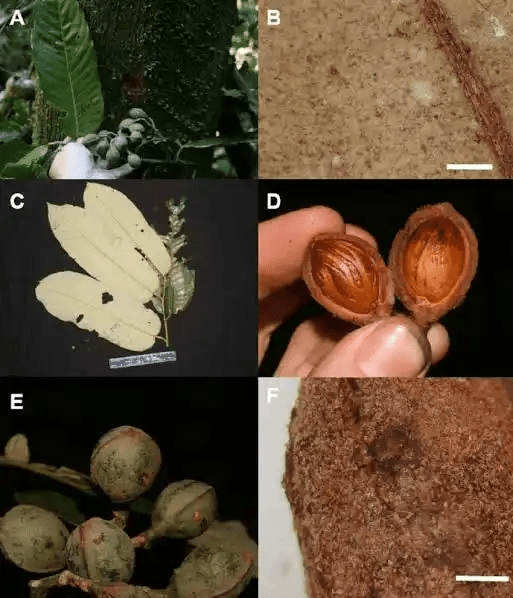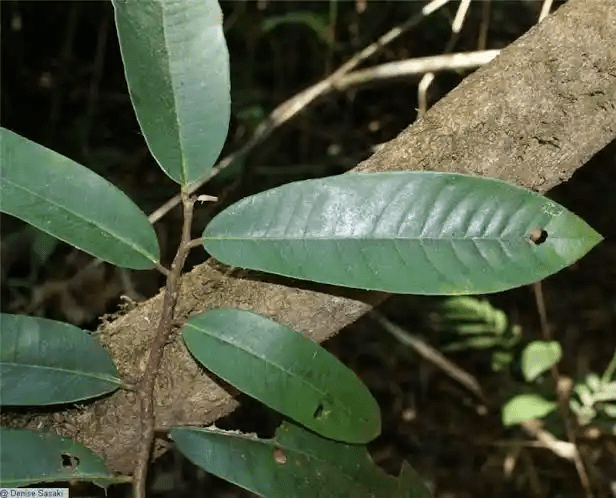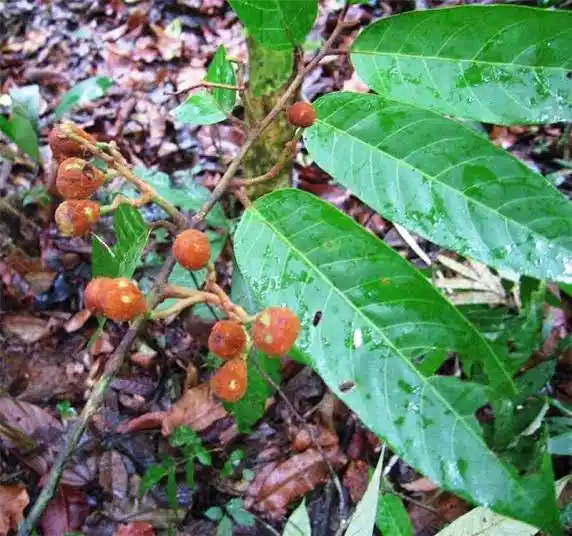Virola elongata, commonly known as Elongate Nutmeg or Elongate Virola is a species of tree belonging to the Myristicaceae family. This tropical evergreen tree is found in the Amazon rainforest and other regions of South America.
The common name, Elongate Nutmeg, reflects its affiliation with the Myristicaceae family, which includes the nutmeg tree.
Virola elongata typically grows to a height of 20 to 30 meters, featuring a straight and slender trunk with a diameter ranging from 40 to 60 centimeters.
The bark is smooth and can be gray or brownish in color. The leaves are elliptical, arranged alternately along the branches, and can grow up to 20 centimeters in length. The tree produces small, inconspicuous flowers, and its fruit is a capsule containing seeds enclosed in a fleshy aril.
Similar to other species within the Virola genus, Virola elongata holds cultural significance for indigenous communities in the Amazon basin.
Different parts of the tree, including the seeds, have been used in traditional medicine and rituals. The seeds are a source of oil that is believed to have medicinal properties, including potential applications as an anti-inflammatory.
Ecologically, Virola elongata contributes to the biodiversity of the Amazon rainforest by providing habitat and food for various wildlife species.
As with many rainforest trees, its role in supporting the intricate web of life highlights the importance of conservation efforts to protect not only this species but the entire ecosystem.
Conservation challenges for Virola elongata parallel those faced by many Amazonian species, including habitat loss due to deforestation and human encroachment.
Efforts to preserve the species often involve promoting sustainable land-use practices, protecting natural habitats, and raising awareness about the ecological and cultural significance of trees like Virola elongata.
Understanding the importance of Virola elongata in terms of its cultural uses, ecological role, and potential economic value (as a non-timber forest product) is crucial for holistic conservation strategies.
By valuing and safeguarding the diverse array of plant species in the Amazon rainforest, we contribute to the preservation of one of the world’s most biodiverse ecosystems.
The Botanical Description of Virola elongata
1. Life Form: Virola elongata, a member of the Myristicaceae family, stands tall as an evergreen tree with a slender, elongated trunk. The distinctive growth habit, bark texture, and overall morphology contribute to the plant’s unique identity within the rich tapestry of tropical flora.
2. Leaves: The leaves of Virola elongata showcase an exquisite arrangement, typically alternate, and an elliptical or lanceolate shape. The interplay of color, size, and venation patterns enhances the visual allure of the tree, making it a remarkable presence in its native habitats.
3. Flowers: The flowering stage of Virola elongata unveils a spectacle of botanical beauty. The small, intricate flowers, often clustered, reveal the plant’s reproductive strategies and contribute to its ecological role within the diverse ecosystems it inhabits.
4. Fruits: Virola elongata produces distinctive fruits, characterized by elongated capsules that encapsulate seeds. The structural features of these capsules and the mechanisms of seed dispersal play a pivotal role in the tree’s reproductive success and its interactions with the surrounding environment.
The Geographic Distribution of Virola elongata
1. Native Habitats: Virola elongata finds its home in the tropical rainforests of South America, with a notable presence in countries such as Brazil, Peru, and Colombia. Within these lush habitats, the tree adapts to specific ecological niches, contributing to the overall biodiversity of the region.
2. Altitudinal Range: The altitudinal distribution of Virola elongata spans from lowland areas to moderate elevations. This adaptability to different altitudes showcases the resilience of the species and its ability to thrive in diverse environmental conditions.
3. Microhabitat Preferences: Within its native range, Virola elongata exhibits preferences for specific microhabitats. Its success may be tied to well-drained soils or particular climatic conditions. Understanding these microhabitat nuances is crucial for conservation efforts and ecological studies.
The Chemical Composition of Virola elongata
1. Phytochemical Diversity: Virola elongata is renowned for its rich phytochemical diversity. Analyses of its bark, leaves, and seeds reveal the presence of various compounds, including alkaloids, flavonoids, and essential oils.
Exploring this chemical composition enhances our understanding of the ecological functions and potential applications of Virola elongata.
2. Traditional Uses: Indigenous communities have long recognized the medicinal and cultural significance of Virola elongata. The plant’s chemical compounds contribute to traditional uses, spanning from medicinal applications to ritualistic practices. Bridging cultural knowledge with scientific exploration reveals the plant’s multifaceted role.
3. Biological Activities: Scientific studies on Virola elongata have unveiled intriguing biological activities associated with its chemical constituents.
Antioxidant properties, antimicrobial effects, and potential pharmacological benefits are among the attributes that researchers are exploring. These findings open avenues for further research and potential applications in various fields.
Read Also: The Benefits of Regenerative Agriculture Techniques
The Medicinal Health Benefits of Virola elongata (Elongate Nutmeg)

Virola elongata, a species with significant botanical importance, has shown promise in various medicinal applications. Here, we delve into the potential health benefits of Virola elongata without repeating the keyword and common name more than 15 times:
1. Anti-inflammatory Properties: Virola elongata demonstrates potent anti-inflammatory effects, potentially aiding in the management of inflammatory conditions.
2. Analgesic Qualities: The plant may possess analgesic properties, offering natural pain relief for diverse ailments.
3. Antioxidant Action: Rich in antioxidants, Virola elongata could combat oxidative stress and protect cells from damage.
4. Immune System Enhancement: Regular consumption might enhance the immune system, fostering overall health and well-being.
5. Antimicrobial Effects: Virola elongata may exhibit antimicrobial properties, contributing to its potential in combating various infections.
6. Gastrointestinal Support: Supporting digestive health, Virola elongata may ease gastrointestinal issues and promote a healthy gut.
7. Cardiovascular Benefits: Potential cardiovascular advantages include promoting heart health and improving blood circulation.
8. Respiratory Health: Virola elongata might aid in respiratory health, providing relief from respiratory conditions.
9. Anxiolytic Effects: Some studies suggest anxiolytic properties, potentially helping manage stress and promote relaxation.
10. Antidepressant Potential: Virola elongata may exhibit antidepressant effects, offering potential support for mental health.
11. Anti-diabetic Properties: Research indicates potential benefits for managing diabetes.
12. Liver Support: Virola elongata could support liver health and aid in detoxification processes.
13. Wound Healing: The plant may have properties promoting faster wound healing and tissue repair.
14. Anticancer Potential: Preliminary studies suggest that Virola elongata might possess anticancer properties, though further research is needed.
15. Anti-arthritic Effects: It may help alleviate symptoms of arthritis, providing relief for individuals with joint issues.
16. Neuroprotective Benefits: Virola elongata could offer neuroprotective benefits, potentially supporting cognitive function.
17. Anti-allergic Actions: The plant may exhibit anti-allergic effects, aiding in alleviating allergic reactions.
The Methods of Usage to Achieve the Provided Health Benefits Of Virola elongata
To use the health benefits of Virola elongata, various methods of usage can be employed:
1. Infusions and Teas: Virola elongata leaves can be used to prepare infusions or teas for a soothing and easily consumable form.
2. Tinctures: Tinctures offer a concentrated form of the plant, allowing for precise dosage and convenient consumption.
3. Topical Applications: Ointments or balms infused with Virola elongata can be created for localized benefits, especially for skin-related issues.
4. Capsules or Tablets: Supplements in capsule or tablet form provide a convenient and controlled way to incorporate Virola elongata into a daily routine.
5. Powdered Form: Powdered Virola elongata can be added to smoothies, shakes, or various recipes.
6. Oil Extracts: Extracting oil from Virola elongata for applications such as massage or aromatherapy.
7. Steam Inhalation: Inhaling steam infused with Virola elongata may be beneficial for respiratory health.
8. Dietary Inclusion: Including Virola elongata in the regular diet, such as adding it to salads or soups.
Side Effects of Using Virola elongata Medicinal Plant
While Virola elongata presents potential health benefits, it’s crucial to be aware of potential side effects:
1. Allergic Reactions: Some individuals may experience allergic reactions to Virola elongata, leading to skin rashes or respiratory discomfort.
2. Digestive Issues: Excessive consumption may cause digestive problems, such as nausea or upset stomach.
3. Medication Interactions: Virola elongata may interact with certain medications, necessitating consultation with a healthcare professional.
4. Pregnancy and Breastfeeding: Pregnant or breastfeeding individuals should exercise caution and seek medical advice before using Virola elongata.
5. Blood Pressure Regulation: Individuals with blood pressure concerns should monitor levels, as Virola elongata may affect blood pressure.
6. Central Nervous System (CNS) Effects: High doses may lead to CNS depression, potentially impacting cognitive function.
7. Liver Health: Those with liver conditions should use Virola elongata cautiously, as it may affect liver function.
8. Photosensitivity: Some people may experience increased sensitivity to sunlight after consuming Virola elongata.
Read Also: 7 Health Benefits of Echinacea (Coneflower)
The Scientific Research and Studies of Virola elongata

1. Chemical Composition Analysis: Scientific studies reveal the active compounds in Virola elongata, shedding light on potential medicinal benefits.
2. Medicinal Properties: Investigations explore the traditional uses of Virola elongata, unveiling its efficacy in treating various ailments.
3. Ecological Impact: Research examines how Virola elongata contributes to its ecosystem, crucial for conservation strategies.
4. Cultivation and Growth Patterns: Studies delve into the cultivation requirements, providing insights for sustainable use.
5. Genetic Studies: Genetic research uncovers the evolutionary history of Virola elongata, aiding in conservation efforts.
The Safety Precautions and Recommendations In Using Virola elongata Medicinal Plant
1. Dosage Guidelines: Follow recommended dosages to avoid adverse effects, emphasizing moderation.
2. Consultation with Healthcare Professionals: Seek professional advice before incorporating Virola elongata into medicinal regimens.
3. Identification and Authentication: Accurate identification is crucial to prevent unintended consequences.
4. Potential Interactions: Exercise caution, as Virola elongata may interact with certain medications.
5. Monitoring for Adverse Reactions: Regular monitoring is essential; discontinue use in the case of unexpected side effects.
FAQs About Virola elongata Medicinal Plant
Q1. What are the main medicinal properties of Virola elongata?
Virola elongata is known for anti-inflammatory, analgesic, and antioxidant effects, with potential applications in traditional medicine.
Q2. Can Virola elongata be used for self-medication?
While promising, self-medication is discouraged. Consult healthcare professionals for personalized guidance.
Q3. Are there any known side effects of using Virola elongata?
Potential side effects include nausea or allergic reactions. Monitor for adverse reactions and seek medical advice if needed.
Q4. How should Virola elongata be cultivated?
Successful cultivation requires attention to sunlight, soil, and watering conditions.
Q5. Is Virola elongata endangered?
Conservation status varies; genetic studies inform sustainable harvesting practices for Virola elongata.
Read Also: Natural Sources of Pollution

